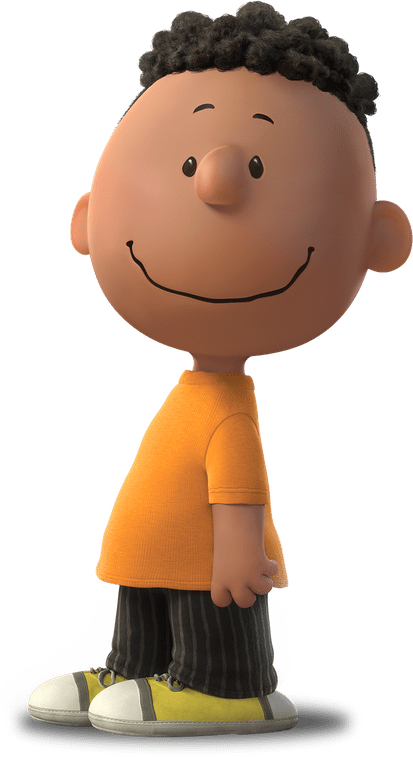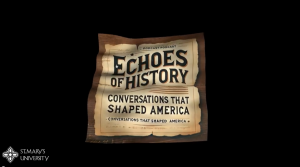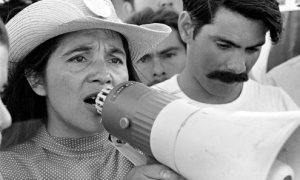Winner of the Spring 2019 StMU History Media Award for
Best Descriptive Article
Best Article in the Category of “Social History”
Many people are familiar with the lovable beagle Snoopy and the other members of Charles M. Schulz’s ‘Peanuts’ comics. The series revolves around Charlie Brown, his friends, and the famous beagle, Snoopy. While Snoopy lives in a fantasy world where he consistently engages in aerial battle with the WWI Red Baron, Charlie Brown must deal with much of life’s disappointments, ranging from receiving rocks in his Halloween candy bag to being tormented by Lucy van Pelt.1 Snoopy has become a household name; the character has even appeared in popular clothing brands such as Levi’s, Vans, and BAGGU. In addition, there are multiple locations around the globe where Charlie Brown and his friends are celebrated. For example, there are museums in Tokyo and California dedicated to both Snoopy and Charles M. Schulz himself, and there’s the famous amusement park, Knott’s Berry Farm, that would later make the Charlie Brown characters a part of their addition. No doubt, the ‘Peanuts’ characters are one of the most well-known cartoon icons. Much of their popularity began in the 1950s; however, the year 1968 was an especially interesting year for the ‘Peanuts’ gang. It was the year Schulz gave way to the comic’s first black character, and the year Franklin Armstrong became part of the ‘Peanuts’ family. Although a small act, Franklin’s debut became a big step in normalizing integration and it marked Schulz as one of the most influential cartoonists of all time.2
The year 1968 was a big year not only for Schulz, but it was also a big year for the African American population, the Civil Rights movement, and much of the United States. On April 4 of that same year, Martin Luther King Jr. was assassinated in Memphis, Tennessee. His death was met with outrage, and it sparked multiple riots and protests throughout the nation. A few months later, Robert F. Kennedy, an advocate for equality and civil rights, was also assassinated. Just a few years prior to King’s and Kennedy’s death, there was the Little Rock Nine who made one of the first attempts towards desegregation in public white schools. As many had already predicted, the Little Rock Nine were not welcomed by white students, and were instead greeted through physical and verbal abuse.3 It’s hard to say the United States was making much progress towards equal rights and desegregation, but it was still making some attempts. One of these attempts was made by Schulz and a retired teacher who resided in Southern California, Harriet Glickman.4
Harriet Glickman was both a teacher and a mother of three children, and, in the wake of Martin Luther King Jr.’s assassination, felt the need to spark some sort of hope during such a dark and rough time. Glickman explains her motive in an interview, “I was thinking about Dr. King, and about having lived through so many years of struggles and the racism and the [divisiveness] that existed.”5 Having children of her own, Glickman recognized how powerful and impactful comics were at the time. She realized, however, that many young comic fans had yet to see any type of diversity in any of the comic strips. Glickman said, “And my feeling at the time was that I realized that black kids and white kids never saw themselves [depicted] together in the classroom.”6 With that in mind, Glickman made it a priority to pen letters to several cartoonists; she requested that they offer images of integration and diversity in their comic strips, and she suggested that they include a colored individual as one of their main characters.7

Glickman first got in touch with the author of the “Mary Worth” comic series, Allen Saunders. Both Saunders and his artist, Ken Ernst, thought that the idea of integration would be nice. However, they feared being dropped from the syndicate, telling Glickman that “it is still impossible to put a Negro in a role of high professional importance and have the reader accept it as valid…He too would be hostile and try to eliminate our product.”8 Unfortunately, Saunders and Ernst walked away from Glickman’s proposal. But Schulz wrote back to Glickman expressing interest in the idea. However, like Saunders and Ernst, he was also very hesitant in moving forward with Glickman’s vision, primarily because he did not want to integrate characters in the comics out of fear that he would sound condescending to the African American race. Glickman acted quickly upon Schulz’s response, telling him she thought it would be a good idea to consult with fellow African American friends and ask for their opinions on integration in the series. She turned to friends Kenneth Kelly and Monica Gunning; they themselves wrote to Schulz encouraging him to move forward with Glickman’s idea. In contrast to what Glickman originally visualized, Kelly expressed that it would be better to add a character of color who would merely stand in the background. In this manner, integration would be introduced slowly and gradually, instead of automatically pushing it to the front line. Shortly thereafter, Schulz wrote back to Glickman with his response, telling her that he had received Kelly and Gunning’s feedback, and he hinted that she would very much be amused with his next comic strip.9

Shortly before the release of his next comic strip, which featured Franklin, Schulz was asked by the head of the United Feature Syndicate if he was sure he wanted the story to be released. Schulz responded with more confidence than ever, telling him they could either release the strip as is or else he would quit. It’s important to know that the ‘Peanuts’ series had already gathered a large fanbase and was very popular at this time, having millions of fans and readers globally. The syndicate had no choice; they had to release the story, otherwise they would risk giving up an already famous and influential cartoonist.10
Schulz released his latest comic strip on July 31, 1968, and it was the day Franklin Armstrong made his debut in the series. Almost fifty years ago, Charlie Brown lost sight of his beach ball and it was later returned to him by the series’ first member of color. Following their encounter, the two friends returned to the seashore and built a sandcastle together.11

Franklin’s debut broke racial barriers and was met with both praise and criticism, and much of the latter would come from the South. Many editors from the South sent messages to Schulz, and expressed that they did not want to see colored children interacting with white children, claiming that schools in the South were already going through a desegregation process. The process itself was already too heavy and controversial in the South, and seeing characters like Franklin in the newspaper was merely distasteful to Southerners.12
While some complained about the comic series introducing a member of color, others complained that Franklin was too bland and boring of a character in comparison to the rest of the ‘Peanuts’ gang. They argued that Franklin was ‘too perfect’ and did not have a defining characteristic much like how Charlie Brown is known for being reluctant and Lucy for being a bit snooty. Instead, Franklin was intelligent, very athletic, and overall, he was a good person. Despite his debut making a groundbreaking statement, he didn’t seem to meet the expectations of many. However, what many forget is that Schulz feared sounding patronizing or condescending in his creation of Franklin, and therefore had to be careful in how he characterized him.13
Regardless of the criticism Schulz received, the comic strip was successful in giving the African American population some representation and a place in society. This particularly rang true for Robb Armstrong, who was just six years old at the time of Franklin’s debut. Franklin’s appearance in the comic series was remarkable and touching for Armstrong, who had told his mother he wanted to be a cartoonist. He later became the creator of both Fearless: A Cartoonist’s Guide to Life and Jumpstart and even met Schulz after having sent the latter a comic strip of his own.14 A few year later, Schulz called Armstrong to ask if Franklin could bear the latter’s last name, having realized the character was only known as “Franklin.”15
Recently, in 2018, the ‘Peanuts’ series was met with outrage and was accused of racism because of a particular scene in the movie “A Charlie Brown Thanksgiving.” The scene depicted Charlie Brown and his friends sitting around a table, with most of them sitting on one side of the table and Franklin sitting by his lonesome on the other side. Many viewers took this scene as a hint towards segregation. This backlash in itself is ironic, as the reason Franklin was introduced to begin with was to fight back against racism and to normalize integration, especially in schools. Without Glickman’s impulse on making a statement and Schulz’s confidence in his influence as a cartoonist, Franklin may not have ever existed to begin with. The people of today may point fingers at the series all they want, but no one can deny Franklin’s bittersweet backstory, Glickman and Schulz’s good intentions, nor the impact it would have on the many readers living in such a despairing time.
- Britannica, 2009, s.v. “Peanuts,” by Michael Ray. ↵
- Stan Friedman, “50 Years Ago, Teacher Spurred Integration in ‘Peanuts’ Strip,” COV (blog), August 1, 2018, https://covenantcompanion.com/2018/08/01/50-years-ago-teacher-spurred-integration-in-peanuts-strip/. ↵
- Ha Thu-Huong, “The Sweet Story Behind Peanuts’ Groundbreaking First Black Character,” Quartz, December 11, 2015, https://qz.com/571393/the-sweet-story-behind-peanuts-groundbreaking-first-black-character/. ↵
- Kamp David, “Guess Who’s Coming to ‘Peanuts,’” The New York Times, January 13, 2018, https://www.nytimes.com/2018/01/13/opinion/sunday/peanuts-franklin-charlie-brown.html. ↵
- Kavna Michael, “Franklin Integrated ‘Peanuts’ 47 Years Ago Today. Here’s How a Teacher Changed Comics History,” The Washington Post, July 31, 2015, https://www.washingtonpost.com/news/comic-riffs/wp/2015/07/31/franklin-integrated-peanuts-47-years-ago-today-heres-how-a-teacher-changed-comics-history/?noredirect=on&utm_term=.281dcb22ddaf. ↵
- Kavna Michael, “Franklin Integrated ‘Peanuts’ 47 Years Ago Today. Here’s How a Teacher Changed Comics History,” The Washington Post, July 31, 2015, https://www.washingtonpost.com/news/comic-riffs/wp/2015/07/31/franklin-integrated-peanuts-47-years-ago-today-heres-how-a-teacher-changed-comics-history/?noredirect=on&utm_term=.281dcb22ddaf. ↵
- Kavna Michael, “Franklin Integrated ‘Peanuts’ 47 Years Ago Today. Here’s How a Teacher Changed Comics History,” The Washington Post, July 31, 2015, https://www.washingtonpost.com/news/comic-riffs/wp/2015/07/31/franklin-integrated-peanuts-47-years-ago-today-heres-how-a-teacher-changed-comics-history/?noredirect=on&utm_term=.281dcb22ddaf. ↵
- Tom Heintjes, “Crossing the Color Line (in Black in White): Franklin in “Peanuts”,” Hogan’s Alley, July 31, 2013, http://cartoonician.com/crossing-the-color-line-in-black-and-white-franklin-in-peanuts/. ↵
- Wong Kevin, “Franklin Broke Peanuts’ Color Barrier In The Least Interesting Way Possible,” Kotaku (blog), July 31, 2018, https://kotaku.com/franklin-broke-peanuts-color-barrier-in-the-least-inter-1793843085. ↵
- Kavna Michael, “Franklin Integrated ‘Peanuts’ 47 Years Ago Today. Here’s How a Teacher Changed Comics History,” The Washington Post, July 31, 2015, https://www.washingtonpost.com/news/comic-riffs/wp/2015/07/31/franklin-integrated-peanuts-47-years-ago-today-heres-how-a-teacher-changed-comics-history/?noredirect=on&utm_term=.281dcb22ddaf. ↵
- Cecilia Lei and James Delahoussaye, “‘Peanuts’ First Black Character Franklin Turns 50,”NPR, July 29, 2018, http://www.npr.org/2018/07/29/633544308/peanuts-character-franklin-turns-50. ↵
- Wong Kevin, “Franklin Broke Peanuts’ Color Barrier In The Least Interesting Way Possible,” Kotaku,July 31, 2018, https://kotaku.com/franklin-broke-peanuts-color-barrier-in-the-least-inter-1793843085. ↵
- Wong Kevin, “Franklin Broke Peanuts’ Color Barrier In The Least Interesting Way Possible,” Kotaku,July 31, 2018, https://kotaku.com/franklin-broke-peanuts-color-barrier-in-the-least-inter-1793843085. ↵
- Axelrod Jim, “The Surprising Story behind Franklin, the First Black “Peanuts” Character,” CBS News, August 02, 2018, http://www.cbsnews.com/news/the-surprising-story-behind-franklin-the-first-black-peanuts-character/. ↵
- Cecilia Lei and James Delahoussaye, “‘Peanuts’ First Black Character Franklin Turns 50,”NPR, July 29, 2018, http://www.npr.org/2018/07/29/633544308/peanuts-character-franklin-turns-50. ↵



97 comments
Mariah Cavanaugh
Harriet Glickman is the embodiment of everything that is right in the world. For her to recognize the fact that children did not have any representation of mixed-race friendships at the time is astonishing. While it is frustrating that Schulz was initially hesitant to add a character of color we obviously have a hero in Harriet Glickman who convinced him otherwise.
Mariah Garcia
Growing up, I was a huge Peanuts fan, especially of the Holiday Specials which have become something of a tradition for me. That being said, Franklin was a character like Shermy, one that was not very noticeable. But to read of his origin in this article has given me a deeper appreciation for Charles M. Schulz’ work. This was definitely eye-opening, to say the least.
Sydney Aleman
The Charlie Brown movies and comics were and continue to be my favorite. I have always loved watching the movies and grew up watching them with my grandfather. Till this day anytime my grandfather writes me letters or special occasion notes he always signs, ” love papa and Snoopy dog howl” with a dancing little snoopy dancing. I never knew the reason behind the making of Franklin’s character and it was very fascinating to hear about and to know the back story.
Priscilla Reyes
Growing up I did not watch these cartoons but I can see how incorporating an African American child in cartoons was very crucial. I do remember thanking God for MLK and the Civil Rights Movement because I felt I was going to suffer for my skin color. I even feared I would not be able to be friends with people of the same race but a little lighter. I did not know enough, but I know now that this would have been impactful. I look forward to telling about it!
Antonio Coffee
This article was very informative and used images in a great way. All of the images improved the story and was relevant to where they were placed. It was great that we were able to see the strip where Franklin made his debut. I applaud Schulz for making sure there was representation in his comics and that he tried to be sensitive to the issue of stereotyping while creating the character of Franklin.
Engelbert Madrid
The Peanuts series are one of the most iconic cartoons in the world, and it remains to be popular around all ages despite that it is an old cartoon. It is quite sad to me how white Americans would make a big deal of having an African American character in a famous cartoon, but this was an important part of culture and media history. I’m glad to read this article.
Makenzie Santana
I don’t think I ever viewed the integration of skin color in something as simple as a children’s cartoon loved by families all over would be so influential in society. I am glad reading this article has educated me in this kind of view and love and appreciate now knowing this. Charlie brown is one of the pure things I remember growing up watching, and I have realized that I had the privilege to grow up not having to worry about segregation in silly things like television.
Rosario Moreno
I have loved Charlie brown cartoons for as long as I remember whether it was shown during school days on a bulky tv, or at home during the holidays it is always a favorite. I never knew that Franklin came later on in the comics, but I believe it was important to show Franklin in his cartoon and comics despite what he knew the feedback might be. Whether people supported Franklin or didn’t, this was a huge step by Charles M. Schulz, and it help move the African American movement by showing him in one of the most popular media outings at the time.
Nathalie Figueroa Soto
I used to read The Peanuts all the time when I was younger, and I had loved the comics. It’s been years since I’ve read anything, but reading about this historical aspect of these usually silly comics was incredible to read and find out about. People today are still sometimes having trouble integrating people of color into movies and T.V. shows, so I can’t imagine how terrifying it must have felt for them to debut Franklin in the comics. And yet, with that fear also came hope of acceptance. The purpose of Franklin was to introduce a character of color so that they would become normalized in media, so that other, younger people of color could see him and relate to him. This article easily conveyed this message to me, so well done!
Emily Velazquez
WOW. I loved the Charlie Brown characters growing up. They were always so fun to watch and reading this article and about some of the episodes brought back memories not only of the show but of my family sitting and watching together. Although it was just a TV show, I think that it did make a positive impact on the integration of African Americans at the time. Of course, there is always going to be those who criticize but the intentions of incorporating a cartoon of color was good and that is what matters. Great article!